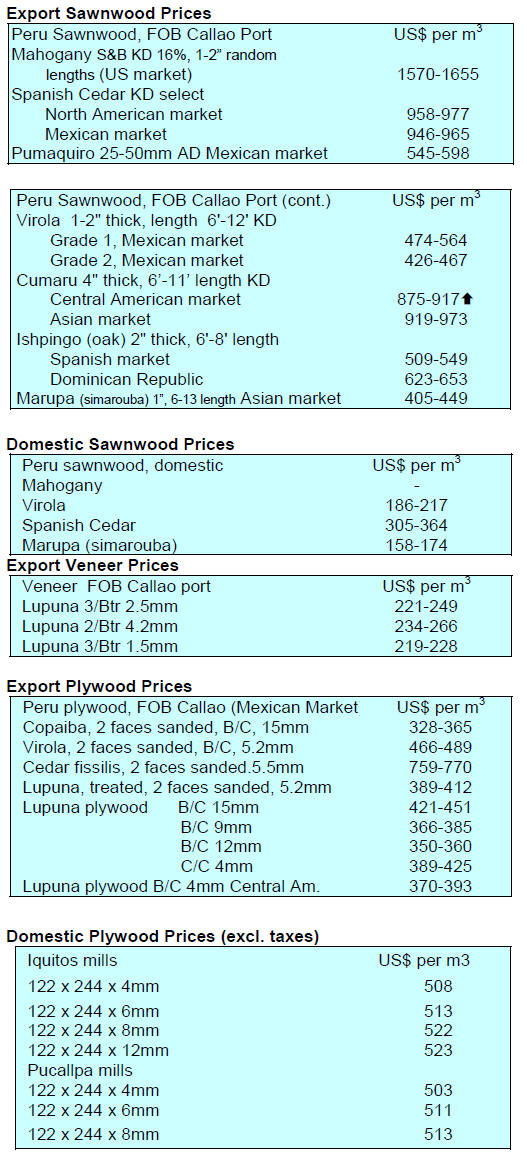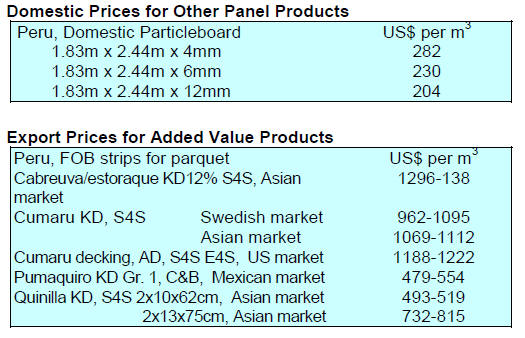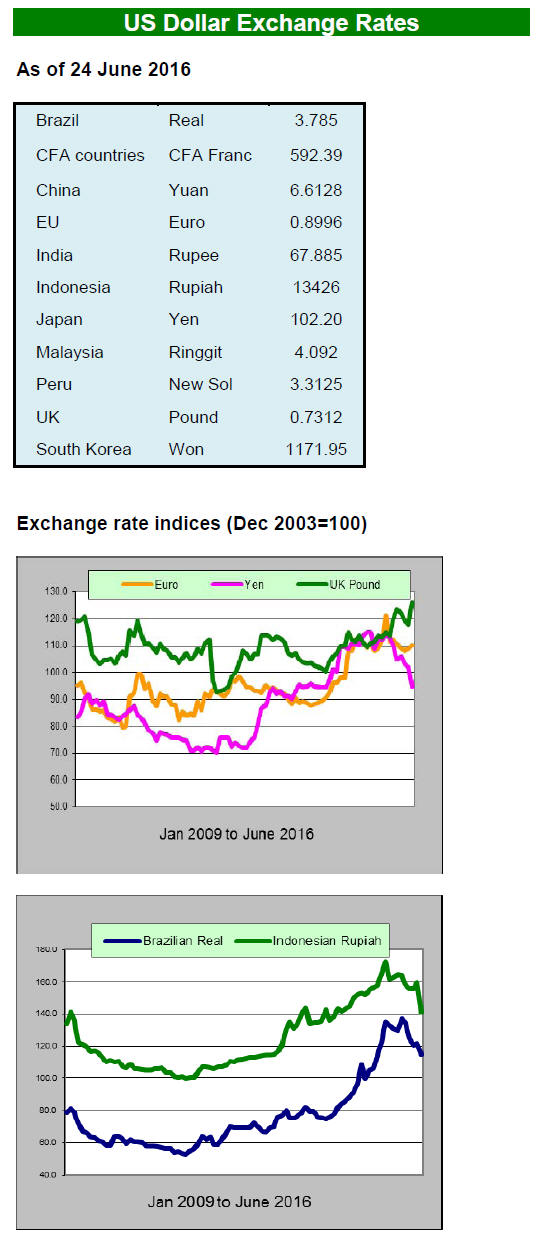2. GHANA
First quarter export contract volumes drop
28%
The total volume of Timber Industry Development
Division (TIDD) approved export contacts in the first
quarter 2016 was 86,335 cu.m, a drop of 28% when
compared to approvals in the final quarter of 2015.
The table below shows that there was a steep fall in
approvals for export of primary and secondary products,
with only the small volume of tertiary product exports
registering growth.
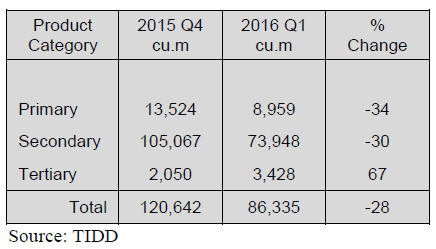
Exports of primary products in the first quarter
fell 33%
year on year due mainly to a decline in shipments of teak
logs/billets (-85%).
Secondary product exports also fell (-30%) to a low of
around 74,000 cu.m; while tertiary product exports
increased of 67% to 3,428 cu.m.
In the first quarter sawnwood accounted for 64% (55,409
cu.m) of the volume of all approved export contracts while
plywood accounted for a further 12% (10,292 cu.m).
Regional West African markets continued to be the major
market for plywood, while for tertiary products, such as
sliced veneer and kiln dried sawnwood, the main markets
were in Europe. Species such as rosewood (air-dried
sawnwood) and high lumber density species such as apa,
ekki and denya were mainly for the Chinese market.
Mahogany and cedrella sawnwood along with rotary
veneer found a ready market in the US. Middle East and
Egyptian markets emerged as a major destination for
backing grade veneer, with India the main market for teak
sawnwood and gmelina logs.
Ghana a PEFC member along with Cameroon and
Gabon
An early June press release from PEFC welcomed Ghana
as a National member. A spokesperson for PEFC said they
were delighted to welcome Ghana as our latest PEFC
National member, the third in Africa, alongside Cameroon
and Gabon.
Emmanuel Amoah Boakye at the Working Group on
Forest Certification said "Joining the PEFC Alliance is a
vital step towards gaining international recognition for our
Ghanaian National Forest Certification System."
When Ghana¡¯s scheme gains PEFC endorsement the
forestry and timber sectors will be able to demonstrate
their sustainable forest management practices and
confidently promote exports.
See:
http://www.pefc.org/news-a-media/general-sfm-news/2135-
Strategies for sustainable forest management
A workshop aimed at equipping forestry practitioners with
the requisite knowledge, tools and skills on certification
recently held in Accra. This brought together forestry
practitioners in government organisations, academic and
research institutions, civil society organisations and the
private sector from the region.
The workshop programme organised by the Africa Forest
Forum in collaboration with the Forestry Research
Institute of Ghana (FORIG) and the Economic Community
of West African States (ECOWAS), was expected to
enhance the understanding of participants on the
implementation strategies for sustainable forest
management.
The Director of FORIG, Dr. Daniel Ofori, said with
increasing demand in consumer countries for forest
products producers with certified forests operations would
find marketing so much easier and could enjoy price
premiums.
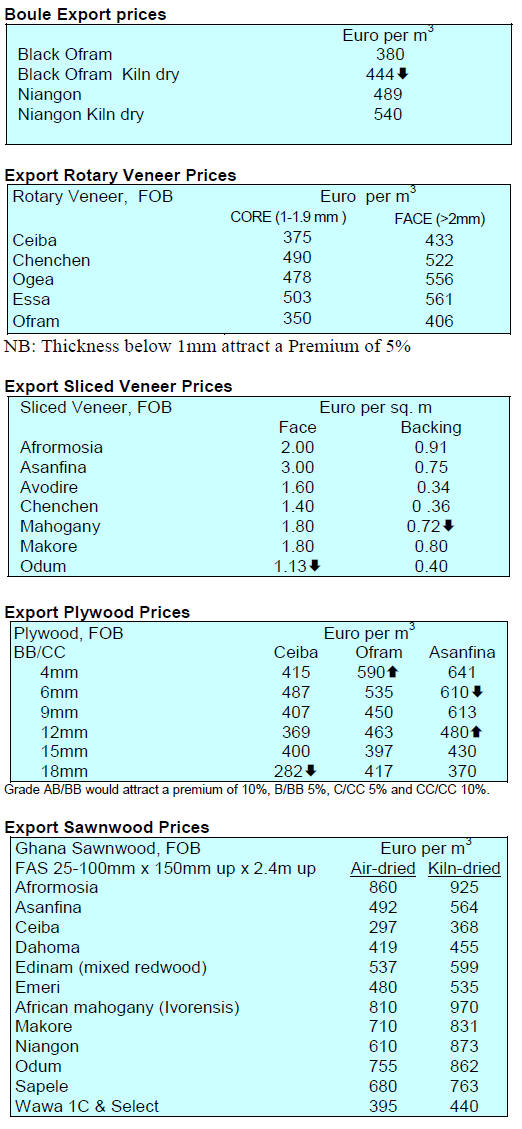
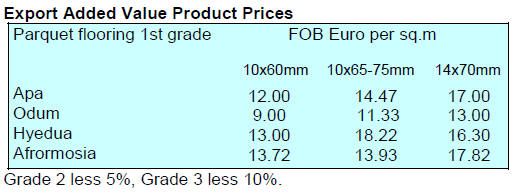
3. MALAYSIA
Look beyond traditional markets to
expand exports
The Malaysian International Furniture Fair (MIFF) has
become a major fixture for the international furniture trade
for many years. The 12th MIFF was held recently in Kuala
Lumpur and the organiser, UBM Malaysia, said visitors
from around 130 countries attended, a good measure of the
international appeal of MIFF.
Speaking at the opening, Minister of Plantation Industries
and Commodities, Douglas Uggah Embas, urged the
furniture industry to develop imaginative export strategies
and look beyond the traditional markets so as to whether
the current global financial turmoil. He said emerging
markets in ASEAN and Asia Pacific have high growth
potential.
Weak demand in major markets dampens Sarawak
export performance
The export performance of Sarawak wood products for the
first quarter of 2016 weakened by around 2% to RM1.62
billion compared to RM1.65 billion during the same
period in 2015. This said the Minister was mainly the
result of a slump in global demand.
The decline was most obvious in the main importing
countries such as Japan, Taiwan P.o.C, China, Thailand
and Middle East countries.
The value of first half 2016 plywood exports, the main
wood product exported from Sarawak, fell almost 14% to
RM791.5 million. In view of this, said the Minister, the
state government was considering measures to support
exporters such as strong promotion of the Sarawak Timber
Legality Verification System (STLVS) to drive
international recognition.
Sharp drop in Sabah sawnwood exports
The latest data from the Sabah Department of Statistics
showed exports of 56,885 cu m of sawnwood in the first
four months of the year valued at RM 109,192, 729. Over
the same period last year, Sabah exported 77,953 cu m of
sawnwood valued at RM 130,824,784.
In the period January to April 2016, Sabah exported
187,180 cu.m of plywood valued at RM 359,208,744
compared to the 192,690 cu.m valued at RM 336,442,072
exported in the same period in 2015.
Endorsement for Malaysia¡¯s latest MC&I for Forest
Plantations
A press release from PEFC has reported that the
Malaysian Criteria and Indicators (MC&I) for Forest
Plantations, as complementary to the Malaysian Timber
Certification Scheme (MTCS) which includes the MC&I
for Natural Forests has been endorsed.
The endorsement of this second edition of the MC&I for
Forest Plantations, which is designed to assess the
management practices for, and enable the certification of,
forest plantations, follows the re-endorsement of the
MTCS in 2014.
PEFC says ¡°These re-endorsements show both the
commitment of our members and underlines PEFC's
leadership in the continuous improvement of forest
certification, we appreciate Malaysia¡¯s continued
commitment, as well as the contributions of all the
stakeholders who have participated in the standards
revision and assessment processes.¡±
See:
http://www.pefc.org/news-a-media/general-sfm-news/2143-
german-system-and-malaysian-forest-plantation-standardachieve-
pefc-re-endorsement
4. INDONESIA
Indonesian FLEGT wood products possible
by year
end
Vincent Guerend, the EU Ambassador in Indonesia has
outlined the process through which the European
Parliament and the European Council will undertake a
process that will ultimately lead to confirmation that
Indonesian timber products satisfy the EU¡¯s legality
standards.
This process must be undertaken before any FLEGT
licensed shipments can be made to EU member states.
Guerend said the process started in the middle of June and
will continue for around two months. The process is
expected to run without problems and it is anticipated that
after 90 days of confirmation Indonesian FLEGT timber
shipments will begin.
Past mistakes in forest management costing millions
to correct says Vice President
Indonesia¡¯s Vice President, Jusuf Kalla, has had harsh
words on Indonesia¡¯s past forest management saying the
forests were exploited in the hope that poverty would be
eliminated but only a few prospered and the impact on the
environment was so severe that it is costing trillions for
forest rehabilitation.
This opinion was voiced during the launch of Environment
and Forestry Week in Jakarta. The Vice President said
despite there being appropriate regulations forests were
recklessly exploited.
The Vice President made the point that this mistake was as
much the responsibility of Indonesia as the importing
countries which paid scant regard to the impact of heavy
harvesting. Indonesia has launched several programmes to
restore Indonesian forests such as the 1-million hectare
movement, the 1-billion tree programme and efforts on
forest rehabilitation.
Tax amnesty bill adopted
After prolonged debate and consideration Indonesia has
adopted a tax amnesty bill that it anticipates could result in
billions of off-shore and untaxed dollars coming back to
the country.
Many wealthy Indonesians have kept money overseas but
now those willing to declare their untaxed savings would
be taxed at a rate of between 2-10%, far below the 30%
top income tax rate. The Minister of Finance, Bambang
Brodjonegoro, has said all money coming back home
would give a boost to economic growth and would be
channeled to infrastructure developments.
Indonesian cities growing faster than in neighbouring
countries
According to a recent study by the World Bank, Indonesia
is undergoing a transformation from a rural to an urban
economy. The country¡¯s cities are growing faster than in
other Asian countries at a rate of 4% per year. The impact
of this rapid rate of urbanisation will alter trade patterns
for wood products since domestic demand will expand.
The Bank report estimates that by 2025 Indonesia can
expect to have almost 70% of its population living in
cities. This, says the Bank, could lead to higher economic
growth through formal employment and from the better
labour productivity that generally results from
urbanisation.
The report notes that every 1% growth in urban population
correlated with a per capita GDP increase of 13% in India,
10% in China, and 7% in Thailand.
For more see:
http://pubdocs.worldbank.org/en/45281465807212968/IDNURBAN-
ENGLISH.pdf
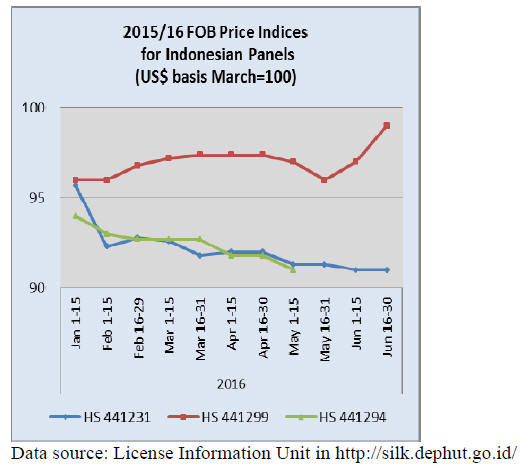
5. MYANMAR
Protecting and rehabilitating remaining
natural forest
the biggest challenge
The Minister of Natural Resources and
Environmental Conservation (MONREC), Ohn Win, has
spoken in an interview with 7Day News of Myanmar on
the challenges for his administration. The first point made
was how to protect the remaining natural forests and
secondly, is it possible to rehabilitate degraded forests so
as to restore some lost forest cover?
These two challenges, said the Minister, are closely related
to ending the illegal timber trade. At the same time as
efforts are made on forest protection and restoration
parallel efforts must be made to repair and recovery
waterways and dams and improve watershed management.
One first step in controlling illegal felling will be
regulation of the import and sale of chainsaws. This is
intended to counter the growing illegal timber trade, which
say many experts, stems from poverty and weak law
enforcement.
MONREC plans to undertake a field resource inventory
and follow this up with satellite mapping to be repeated at
periodic intervals.
MTE to sell log stocks to sustain domestic production
During the one-year suspension of log extraction the
Myanma Timber Enterprise (MTE) is proposing to sell
around 400,000 H.tons of logs.
Of the total, 30,000 H.tons of teak and over 300,000
H.tons of other hardwoods will be sold and priced in US
dollars while 9,000 H.tons of teak and around 60,000
H.tons of other hardwoods will be sold and priced in the
domestic currency.
Emphasis to be on raw material processing for export
Commerce Minister, U Than Myint, has said, while
foreign trade appears set to resume the generally upward
trend of the past five years, efforts will be made to change
in the range of imported goods.
Over recent years there has been a surge in imports of
construction materials driven by demand for buildings by
foreign investors. The Minister said he would now prefer
to see the country both producing and importing raw
materials to be processed for export.
The Minister said the aim of the government is to focus on
boosting agricultural exports and value-added
manufactured goods. To make this a reality, he said, it
may be necessary to amend some laws and regulations to
make exporting easier.
New FDI for plywood and veneer
The Myanmar Investment Commission at its first meeting
approved 8 investments. One of the successful applicants
in timber sector is CO2 Solution Company Limited which
proposes production of high quality veneer and plywood.
This approval comes at a time when logging has been
suspended across the country so analysts ask where the
company will secure raw material if it continues with the
investment.
Local investor face high interest rates
Domestic companies find it very hard to secure financing
and even if they do then interest rates are so much higher
than the rates that investors in Myanmar can obtain offshore.
Myanmar banks apply interest rates in the region of 12%
while overseas banks offer much lower rates. The
disparity in rates is a handicap for domestic companies.
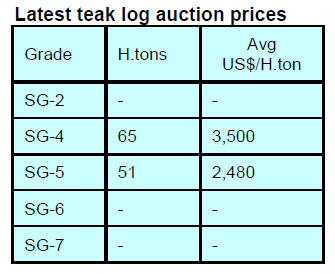
6.
INDIA
Inflation rate trends down
The Office of the Economic Adviser (OEA) to the Indian
government provides trends in the Wholesale Price Index
(WPI).
The official Wholesale Price Index for All Commodities
(Base: 2004-05 = 100) for May rose to 179.4.0 from 177.0
in April. The year on year annual rate of inflation, based
on monthly WPI, stood at 0.79% (provisional) in May
2016 compared to 0.34% in April. Year to May inflation
was -2.2%.
For more see:
http://eaindustry.nic.in/cmonthly.pdf
Timber and plywood price indices climb
The OEA also reports Wholesale Price Indices for a
variety of wood products. The Wholesale Price Indices for
Wood products and Plywood are shown below.
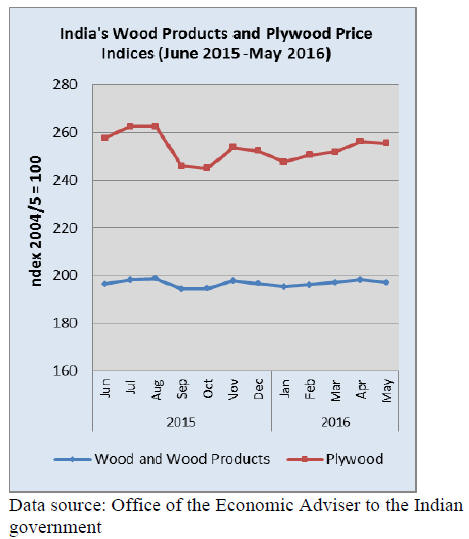
Commercial real estate offers opportunities
A new study from Cushman and Wakefield points out that
it is not only the family housing sector that offers
opportunities in India. Commercial real estate in India is
said to offer investment opportunities especially in the top
tier cities such as Mumbai, Delhi-National Capital Region,
Bengaluru and Pune. The study highlights Real Estate
Investment Trusts (REITs) as the recommended product.
A real estate investment trust (REIT) is commonly a
private sector vehicle attracting investment in incomeproducing
real estate such as office buildings, shopping
malls, apartments, hotels, resorts, and warehouses.
For more see:
http://realty.economictimes.indiatimes.com/news/commercial/rei
t-eligible-commercial-realty-market-in-india-estimated-at-43-54-
billion-rics-cushman-wakefield/52433726
Currency markets un-nerved by RBI news
The Indian rupee began a downward slide against the US
dollar on news that Reserve Bank of India Governor,
Raghuram Rajan, will leave the post in September.
Markets had anticipated he would stay on for a second
term. The rupee seems set for a period of volatility until a
replacement is named. As of mid-June the rupee was down
around 0.75% against the dollar.
The Indian rupee was dealt a further blow on news that
Britain will leave the EU. The Rupee fell to 68 to the
dollar, its lowest level since February, but recovered
slightly.
Dangs division auction results
Log auctions at North and South Dangs Forest Depots
attracted brisk buying.
With Myanmar teak likely to become more difficult to
secure domestic mills are actively buying domestic teak.
The renewed interest in domestic teak lifted prices for both
teak and other hardwoods. Some 4,500 cubic metres of
teak and other hardwoods were auctioned.
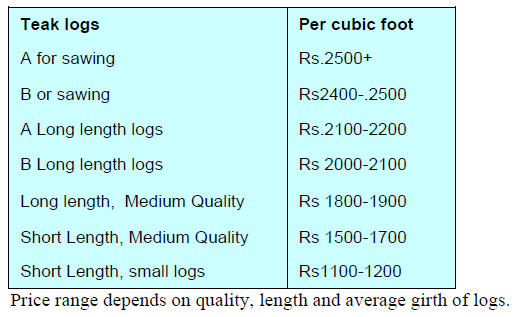
Some ungraded logs were sold at Rs. 900-1,000 per
cubic
foot. Good quality non-teak hard wood logs, 3 to 4 metres
long having girths of 91cms or more of haldu (Adina
cordifolia), laurel (Terminalia tomentosa), kalam
(Mitragyna parviflora) and Pterocarpus marsupium
attracted prices in the range of Rs.800-1,000 per cubic foot
while medium quality logs sold for Rs.400-500 per cubic
foot.
Plantation teak prices
The current pace of deliveries matches demand thus C&F
prices remain stable.
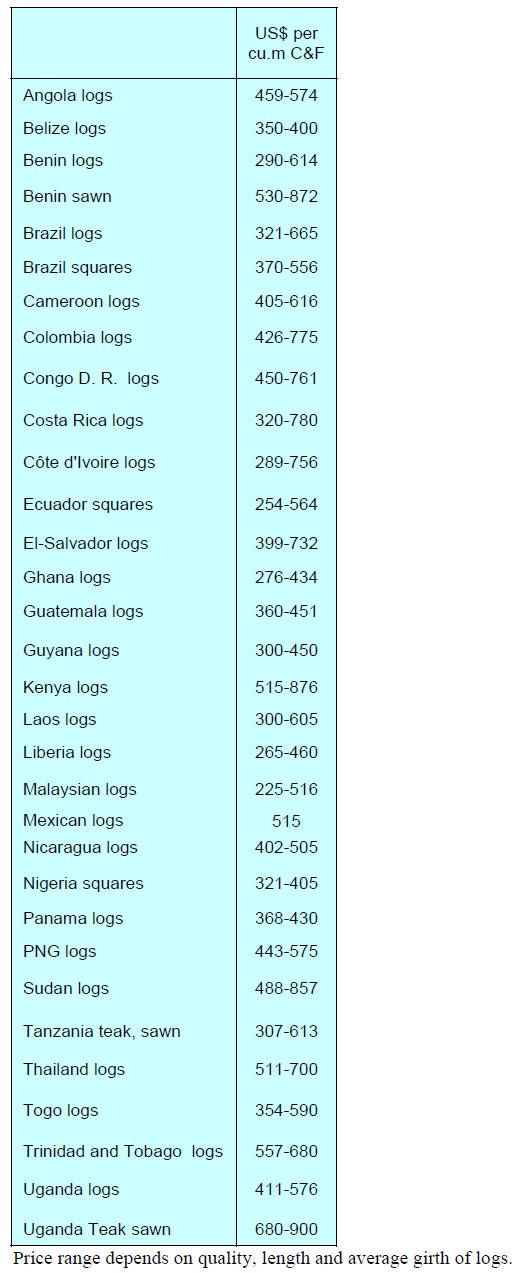
Plantation teak imports via Kandla Port during
fiscal
2015-16 are shown below.
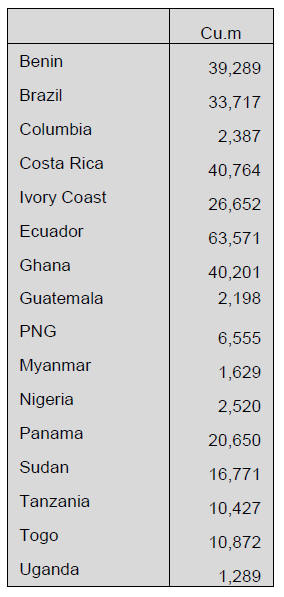
Prices for locally sawn hardwoods
The US dollar/Rupee exchange rate continues to trade in a
narrow band allowing importers to maintain past price
levels.

Myanmar teak flitches resawn in India
Ex-mill prices for sawn teak remain unchanged.
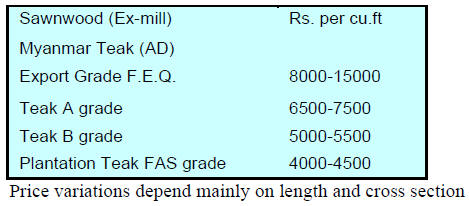
Prices for imported sawnwood
Overall, prices remain unchanged except for American
walnut for which firm demand resulted in an upward
pressure on prices.

7.
BRAZIL
IBA requests strengthening of export
policy
The Brazilian Tree Industry Association (Ind¨²stria
Brasileira de Árvores, IBA) has called for the urgent
development of new government initiatives to support
Brazilian manufacturers and exporters saying that
measures were needed to stimulate the economy and speed
the recovery of the forestry and wood processing sectors.
This call came at a meeting of private sector entrepreneurs
and the Federal Government.
According to IBA, the pulp, paper and wood-based
panels
sectors are making considerable efforts to increase exports
as domestic demand is weak. In addition to an overall
policy IBA called for measures making access to credit
easier and to speed up infrastructure improvements.
At the meeting with the government, the private sector
also stressed the need to stimulate domestic consumption
and reduce interest rates.
Association says Bolivia¡¯s new import regulations
disadvantage furniture exporters
The Bolivian government has introduced new procedures
for imports including wooden furniture. The new law,
Supreme Decree No. 2752, comes into force on 1 July
2016.
Bolivia is one of the main export markets for Brazil¡¯s
wooden furniture and in 2015 wooden furniture
manufacturers in Bento Gonçalves exported more than
US$1.5 million to Bolivia.
Export statistics for the five months to May 2016 indicate
that exports to Bolivia grew more than 30% compared to
the same period in 2015 lifting Bolivia into the top ten
export destinations for Bento Gonçalves manufacturers.
The Bento Gonçalves Furniture Industry Union
(SINDMOVEIS) has appealed to the Ministry of
Development, Industry and Foreign Trade (MDIC) saying
this action by Bolivia could seriously affect furniture
manufacturers in Bento Gonçalves and in the State of Rio
Grande do Sul.
The Bolivian decree imposes various administrative
procedures and the prior authorisation of furniture imports
which, says SINDMOVEIS is discriminatory.
SINDMOVEIS has suggested that the same rules as
applied for the Andean community should be extended to
the Southern Cone Common Market (MERCOSUR).
May export performance
In May 2016 the value of Brazil¡¯s wood product exports
(except pulp and paper) fell 1.6% in compared to May
2015, from US$231.7 million to US$228.1 million.
On the other hand, pine sawnwood export values rose just
over 10% between May 2015 (US$25.5 million) and May
2016 (US$28.1 million). In terms of volume, exports
increased 36% over the same period, from 111,900 cu.m
to 152,300 cu.m.
Tropical sawnwood exports also increased in May rising
11% in volume, from 29,200 cu.m in May 2015 to 32,500
cu.m in May 2016. But the value of exports increased by
just 4% from US$14.8 million to US$15.4 million, over
the same period.
The plywood export performance was mixed with pine
plywood exports falling 3% in value in May 2016 in
comparison with May 2015, from US$35.6 million to
US$34.5 million.
However, the volume of pine plywood exports increased
almost 33%, from 99,100 cu.m to 131,700 cu.m, during
the same period.
As for tropical plywood, export values and volumes both
increased. Export volumes rose 27% from 9,500 cu.m in
May 2015 to 12,100 cu.m in May 2016 while the value of
exports increased almost 9% from US$4.6 million to US$5
million, during the same period.
As has been the general trend over recnt months, wooden
furniture export values dropped from US$38.7 million in
May 2015 to US$36.2 million in May 2016, a 6.5%
decline.
Mobile application for timber tracking
The Brazilian Forest Service (SFB) has launched an
application for smartphones and tablets that allows timber
tracking and concession production. The application
utilises available information from Brazil¡¯s 2015 Chain of
Custody System (CCS).
The CCS captures information on standing trees in
approved logging concessions. When any tree is felled
within the sustainable forest management regime the forest
concessionaire is required to provide information to the
CCS.All transport of logs from forest to industry is also
registered in the system. At a sawmill sawn output is
bundled and each bundle is provided with an identity tag
(QR Code) generated by the CCS.
The CCS system can retrieve data on processed logs and
produces geographic coordinates for logs and sawnwood.
The SFB says the aim of this application is to provide
transparency on forest concessions activities to improve
the confidence of timber buyers that the material being
offered for sale can be tracked through the system to
demonstrate legality. This is important in the domestic and
international market where verified legal timber is now
demanded.
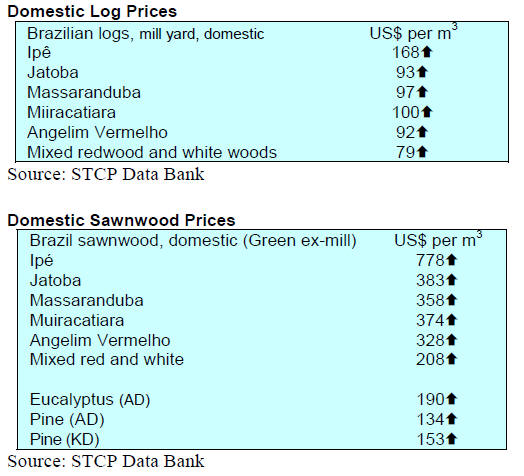
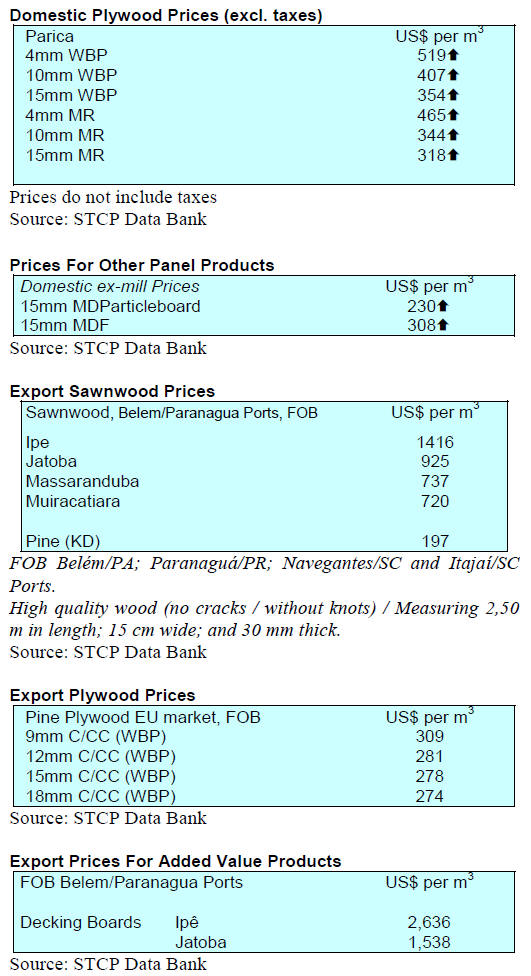
8. PERU
Minagri lists species for
commercialisation
The Ministry of Agriculture and Irrigation (Minagri) has,
through a resolution of the National Forest Service and
Wildlife (SERFOR), released an "Official List of Forest
Species for Exploitation for Commercial Purposes".
This is in support of improved management and
administration of forest resources at the national level and
to facilitate monitoring forest inventories and timber
movements along the supply chain.
The added advantage of the listing will be that more
reliable information will be available for the National
Forest Information System used to generate more reliable
and extensive data for planning.
Guidelines on processes for granting of forest
concessions
The Forestry and Wildlife National Service (Serfor), in
coordination with the Scientific University of Peru Iquitos,
the Regional Government of Loreto and the College of
Engineers of Peru recently concluded a training event
aimed at strengthening the capacity of professionals for
the development and implementation of forest
management plans to ensure the sustainable utilisation of
forest resources.
At this event framework guidelines were developed for the
processes of granting of forest concessions through the
public bidding processes conducted by The National
Forest and Wildlife Service (Serfor).
The Serfor Directorate said these guidelines will
contribute to the sustainable management of the country¡¯s
production forests.
